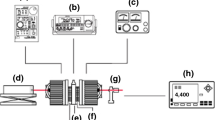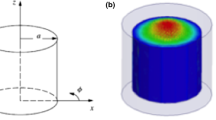Abstract
Vegetable oil becomes polarized on oxidation and polymerization resulting in the formation of peroxide, triglycerides, etc. The quality and reusable state were investigated for sunflower, sesame, rice bran oil and model oil with the addition of oleic acid (2, 4 and 6 %) and antioxidants (citric and tert-Butyl hydroquinone-TBHQ). Excessive reclaims of cooking oil produce toxic by-products due to chemical breakdown that induce the production of polar compounds in oil. To determine the consumable fitness, variations of dielectric constant are observed at different temperatures (29 to 70 °C) and frequencies (1 to 107Hz) for the cooking oil. Physical parameters, such as viscosity and density associated with the saturated and unsaturated fatty acid, are also measured at different temperatures to determine the quality of oil. Dielectric constant and viscosity are correlated and analyzed using a newly developed equation with high correlation constant (R 2 = 0.998) for oil added with citric acid. Oil added with 2–4 % of oleic acid is observed to have high determination coefficient (R 2 > 0.92). A lowest correlation (R 2 = 0.6–0.7) was observed for the oil added with TBHQ. The present study also states that addition of TBHQ to oil does not impede oxidation reaction. Besides, even the shelf life of the oil could not be enhanced and may produce adverse effects in human health.




Similar content being viewed by others
References
Al-Kahtani HA (1991) Survey of quality of used frying oil from restaurants. JAOCS 68(11):857–862
Augustin MA, Asap T, Heng LK (1987) Relationship between measurements of fat deterioration during heating and frying in RBD olein. JAOCS 64(12):1670–1675
Choe E, Min DB (2007) Chemistry of deep-fat frying oil. J Food Sci 72:577–86
El-Shami SM, Zaki Selim I, El-Anwar IM, El-Malah MH (1992) Dielectric properties for monitoring the quality of heated oil. JAOCS 69(9):872–875
Fritsch CW (1981) Measurements of frying fat deterioration. JAOCS 58(3):272–274
Hampikyan H, Colak H, Akhan M, Turgay I (2011) Determination of total polar compound (TPC) levels in frying oil. Food Agric Environ JFAE 9(2):142–144
Hosahalli RS, Cuiren CR, Navneet RS (2015) Comparison of viscoelastic properties of set and stirred yoghurts made from high pressure and thermally treated milks. International Journal of Food Properties, (In press)
Pokorny J, Yanishlieva N, Gordon MH (2001) Antioxidants in food: practical applications. CRC press Taylor and Francis 156 to 159
Kim J, Kim DN, Lee SH, Yoo S-H, Lee S (2010) Correlation of fatty acid composition of vegetable oil with rheological behaviour and oil uptake. Food Chem 118:398–402
Kochhar SP (2000) Stabilisation of frying oil with natural antioxidative components. Eur J Lipid Sci Technol 102:552–559
Kumar D, Singh A, Tarsikka PS (2013) Interrelationship between viscosity and electrical properties for edible oil. J Food Sci Technol 50(3):549–554
Pace WE, Westphal WB, Goldblith SA (1968) Dielectric properties of commercial cooking oil. J Food Sci 33:30–36
Quiles JL, Ramâirez-Tortosa MC, Yaqoob P (2006) Olive oil and health. CABI, Wallingford
Risman PO, Bengtsson NE (1971) Dielectric properties of foods at 3 GHz determined by cavity perturbation technique. J Microw Power 6:101–106
Rubalya VS, Neelamegam P (2012) Antioxidant potential in vegetable oil. Res J Chem Environ 16(2):87–94
Rubalya VS, Chandiramouli R, Neelamegam P (2013) Detection of adulteration in olive oil using rheological and ultrasonic parameters. Int Food Res J 20(6):3197–3202
Rubalya VS, Mukesh Kumar V, Devasena T (2015) Modeling temperature dependent viscosity parameter of vegetable oil and study of physicochemical properties on heating. Int J Food Prop
Soriguer F, Rojo-Martinez G, Dobarganes MC, Garcia Almeida JM, Esteva I, Beltran M (2003) Hypertension is related to the degradation of dietary frying oil. Am J Clin Nutr 78(6):1092–1097
Tjaša P, Blaž C, Rajko V, Nataša Poklar U, Nataša Š (2013) Correlation of basic oil quality indices and electrical properties of model vegetable oil systems. J Agric food Chem 61:11355–11362
Velasco J, Marmesat S, Bordeaux O, Marquez-Ruiz G, Dobarganes C (2004) Formation and evolution of monoepoxy fatty acids in thermoxidized olive and sunflower oil and quantitation in used frying oil from restaurants and fried food outlets. J Agric Food Chem 52(14):4438–4443
Wanasundara PKJPD, Shahidi F (2005) Report: antioxidants: science, technology and applications, Bailey’s industrial oil and fat products. 6:(6)431–489
Warner K, Gehring MM (2009) High-temperature natural antioxidant improves soy oil for frying. J Food Sci 74(6):500–505
Williams MJ, Sutherland WH, McCormick MP, de Jong SA, Walker RJ, Wilkins GT (1999) Impaired endothelial function following a meal rich in used cooking fat. J Am Coll Cardiol 33(4):1050–1055
Acknowledgments
The authors gratefully acknowledge Vice Chancellor of SASTRA University, for the support to carry out the research work in the University Laboratory. We also thank Pondicherry University for helping us to measure dielectric constant at different frequencies.
Author information
Authors and Affiliations
Corresponding author
Rights and permissions
About this article
Cite this article
Valantina, S.R., Susan, D., Bavasri, S. et al. Experimental investigation of electro-rheological properties of modeled vegetable oils. J Food Sci Technol 53, 1328–1337 (2016). https://doi.org/10.1007/s13197-015-2050-6
Revised:
Accepted:
Published:
Issue Date:
DOI: https://doi.org/10.1007/s13197-015-2050-6




